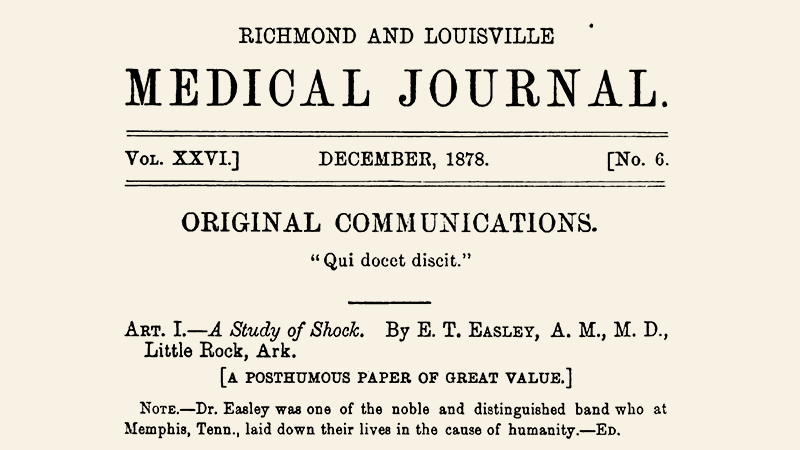As the American College of Surgeons Committee on Trauma (ACS COT) celebrates 100 years of service, milestones of the systems of care that have been built over the past century have been acknowledged and celebrated. Perhaps the most notable milestone is the evolution of emergency medical services (EMS) and the creation of the trauma system itself. Herein we explore the history and impact of each.
EMS
The ACS COT has had a significant impact on the evolution of modern EMS throughout the committee’s history. George G. Davis, MD, FACS, presented a lecture on Transportation of the Injured at the Conference of Traumatic Surgery Symposium during the 1929 ACS Clinical Congress, highlighting the importance of stabilizing fractures, using tourniquets, and avoiding delays. The EMS Committee, which first started as the Subcommittee on the Ambulance Equipment in the Emergency Treatment of Fractures in 1931, chaired by Robert H. Kennedy, MD, FACS, has grown from a small group to a committee of more than 40 members and organizational liaisons.
The EMS Committee has consistently emphasized the importance of the trauma continuum of care that begins when and where injury occurs. From educating first responders through the Prehospital Trauma Life Support (PHTLS) Course, to forming a seminal relationship with the National Association of Emergency Medical Technicians (NAEMT), to the development of the STOP THE BLEED® program that emphasizes the role of the public as immediate responders, the EMS Committee has had, and will continue to have, a profound impact on saving lives around the globe.
Although modern EMS had its major evolution in the 1960s, the COT has always had an interest in transporting injured patients. Robert T. Findlay, MD, FACS, published a review in 1931, “First Aid for Fractures: Methods and Equipment for the Treatment of All Fractures at the Site of Accident and on the Ambulance during Transportation to the Hospital” in The Journal of Bone & Joint Surgery. In the June 1933 issue of the Bulletin of the American College of Surgeons, Dr. Kennedy published the article “Transportation of the Injured,” discussing transportation considerations and splinting techniques. In 1936, a report from the Subcommittee on the Transportation of Fractures recommended basic equipment on ambulances, including splinting devices and proper training for the responder. This committee became the Subcommittee on the Transportation of the Injured in 1949 and continued to call for the transition of the ambulance attendant role from a transporter to a caregiver.
The growth of the automobile industry and the subsequent highway system underscored the need for organized civilian EMS systems. In fact, military personnel returning from World War II were quick to note that emergency care was often better on a remote battlefield than at an intersection down the street. The COT was pivotal in highlighting the need for organized civilian EMS systems for both the government and public. Members of the COT helped publish “Let Them Lie, A Manual of First Aid for the Motorist” in 1955 to educate the public about the importance of avoiding significant movement of motor vehicle crash victims. In 1956, the ACS COT developed and proposed to the US Congress the concept of an emergency medical care system serving travelers on federal highways.
In the 1960s, there was no unified way to contact EMS providers, no standards on ambulances or attendant training, and few functioning EMS agencies at that time. As Chair of the COT Subcommittee on Transportation of the Injured (1965−1974) Joseph D. Farrington, MD, FACS, published “Death in a Ditch” in the June 1967 issue of the Bulletin. This article was one of the first to highlight, on a national level, the training required for ambulance attendants. It also provided the first ambulance equipment list outlining the minimum equipment necessary for emergency vehicles or ambulances.
In 1966, two notable events occurred that started what Dr. Farrington referred to as the “7 Years’ War.” Accidental Death and Disability, the Neglected Disease of Modern Society, published by the National Academy of Sciences National Research Council, assessed the mortality and injury rate among civilians at a time when the number of people killed on the nation’s roadways was near epidemic proportions. This report led to passage of the National Highway Safety Act the same year.
After 1966, the COT and the Subcommittee on Transportation of the Injured played a key role in changing the face of EMS. The National Highway Safety Act had been enacted without built-in guidelines for the proposed action. A minimal equipment list for ambulances, originally created by Oscar P. Hampton Jr., MD, FACS (COT Chair 1964–1968), in 1961, was revised in 1966, although fewer than one-third of the ambulances were equipped as recommended at that time. To this day, the EMS Committee continues to actively support the revision of the list.
The Airlie Conference on Emergency Medical Services, a joint venture of the COT and American Academy of Orthopaedic Surgeons (AAOS) Committee on Injuries, occurred in 1969. A total of 53 representatives of American medicine and government participated in this meeting, during which they developed guidelines for ambulance services, personnel and education, and emergency facilities. In 1969, ambulance design criteria were developed, ensuring that care could be rendered to a patient in the back of an ambulance.
To ensure the ambulance attendant was professionally trained, the COT collaborated with other organizations to develop training criteria. In 1966, the ACS published a pocket manual, Emergency Care of the Sick and Injured. Two years later, the National Academy of Sciences Research Council released Training of Ambulance Personnel and Others Responsible for Emergency Care of the Sick and Injured at the Scene and During Transport: Guidelines and Recommendations.
In 1971, the AAOS published Emergency Care and Transportation of the Sick and Injured. The textbook was first conceived by Walter A. Hoyt, MD, FACS—father of David B. Hoyt, MD, FACS, COT Chair (1998–2002) and Past-Executive Director of the ACS. Subsequent editions have featured ongoing contributions by members of the COT, and this textbook, now in its 11th edition, remains one of the bestselling EMS textbooks available on the market. Finally, the National Registry of Emergency Medical Technicians was formed in 1970 to unify examinations and certifications of prehospital providers on a national level.
In 1973, the US Congress passed the Emergency Medical Services Systems Act. Managed by the Health Resources and Services Administration (HRSA), this act provided funding for more comprehensive state and local government EMS systems. In 1981, the President of NAEMT asked Norman E. McSwain Jr., MD, FACS, to investigate developing a trauma course based on Advanced Trauma Life Support® (ATLS®) principles but focused on prehospital care providers. This course soon became the PHTLS Course. The PHTLS Course was founded on the principle that prehospital care providers could make reasoned decisions regarding patient care when educated on appropriate anatomy and physiology, mechanism of injury, patient assessment, and treatment principles.
After several pilot courses took place in 1983, national promulgation of PHTLS began in 1984 through several regional faculty workshops that trained individuals to administer the course. In 2001, the US Army adopted PHTLS as a standardized program for all Army medics. Undoubtedly, PHTLS has significantly contributed to the improved outcomes of countless trauma patients, and this achievement would have been impossible without the ACS COT’s support.
The goal of trauma care in the field is to establish an airway, treat life-threatening injuries such as hemorrhage, and stabilize fractures, all while maintaining minimal scene times before transport to a trauma center. The COT was pivotal in creating the first field triage guidelines for destination determination of the injured patient in 1976. In 2006, the COT worked with the National Highway Traffic Safety Administration (NHTSA) and the Centers for Disease Control and Prevention (CDC) to support the evidence-based revision of these guidelines along with subsequent revisions in 2009 and 2011. In 2021, with the NHTSA’s support, the EMS Committee led a multidisciplinary technical expert panel, which included feedback from EMS and a comprehensive literature review, in the latest revision of these guidelines (see Figure 1).
Liaison relationships make the EMS Committee unique and offer a specialized ability to both connect and communicate across professional boundaries. These relationships have been a priority since the beginning of committee activities. For example, the EMS Committee was instrumental in the development of the STOP THE BLEED® program. Beginning in 2013, Eileen M. Bulger, MD, FACS, EMS Committee Chair (2012–2015), convened a multidisciplinary panel to conduct a systematic review of the literature and make recommendations regarding external hemorrhage control for EMS providers. Additionally, ACS COT has partnered with the American College of Emergency Physicians (ACEP), NAEMT, and the National Association of EMS Physicians (NAEMSP), on a series of consensus-based guidance documents. These topics include spinal motion restriction practices, the prehospital use of ketamine, prehospital hemorrhage control, prehospital use of tranexamic acid, and spinal motion restriction (see Table 1).
EMS will continue to evolve, and the ACS COT will continue to change as well to meet the needs of patients and providers. Gone are the days when the goal of EMS was to reach a trauma center quickly. EMS is now bringing critical care to the patient. EMS has also moved out of the traditional prehospital setting. Community paramedics are treating patients in their homes and assisting in managing chronic conditions. How do we use community paramedicine to care for the trauma patient? Can we keep a trauma patient who may have to travel hours for follow-up appointments at home to be seen by a community paramedic with telemedicine capability? Providers around the world will look to the COT EMS Committee for guidance on answering these questions and more, and we will deliver. Finally, we need to continue to get young trauma surgeons engaged in EMS. It is the young trauma surgeons who will continue the work of the committee and lead the care of the injured patient of any age, across the entire continuum, into the future.












